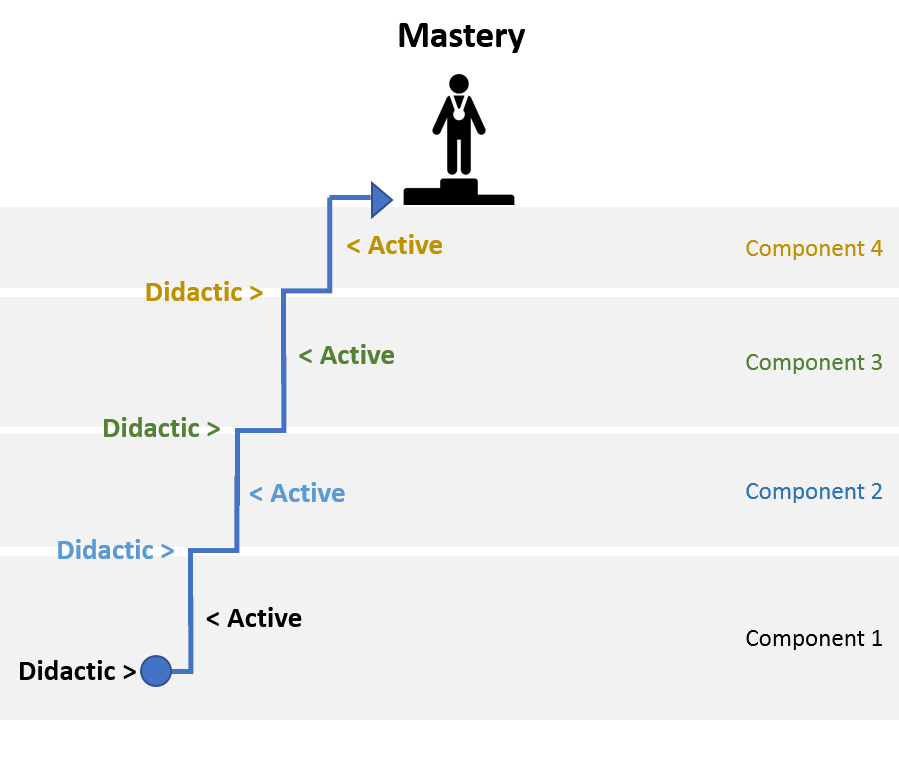Article • August 15, 2019
Why Active Learning is So Important

What does the World Economic Forum have to do with learning and development? Well, if you’re a learning and development (L&D) professional, you might want to take a look at their latest Future of Jobs Report. In it they tell us that the #2 growing skill for 2022 will be active learning and learning strategies, right behind analytical thinking and innovation.
Increasingly, workers will need more than just information to help their organizations succeed. After all, the world has plenty of information: Users on the Internet create 2.5 quintillion bytes of data each and every day. So, the problem isn’t a shortage of information. It’s a shortage of insights. Workers will need to improve their ability to sort through information, prioritize it, and derive meaning from it. They’ll need the ability to draw insights, apply knowledge to solve problems, and be innovative.
In large part, L&D teams are responsible for preparing workers to help their organizations succeed. In our evolving economy, active learning approaches are growing even more necessary to make that happen. The key questions are:
- What is “active learning”?
- How should L&D incorporate active learning into its initiatives?
In this article, we’ll provide some answers.
The Roots of Active Learning
Active learning has its roots in the Constructivist Theory of Learning. Now, there’s quite a lot to this theory, but we’re just going to hit a couple of high points that are relevant to our topic here.
In basic terms, constructivism says that each learner constructs meaning and knowledge for themselves as they learn. In fact, the learner’s act of constructing meaning is learning. Each learner constructs that meaning by leveraging their own personal experiences and the associative neural networks they’ve built.
One critical “takeaway” from constructivism is that educators should focus learners on more than just the subject being taught, but also on thinking about the learning process itself. From an L&D standpoint, this means that disseminating facts isn’t enough. You need to help the learner truly engage with the content and fit it into their own system of meaning.
In short, constructing meaning happens in the mind, but applying different techniques such as kinesthetic learning can greatly enhance the process. When L&D creates programs that truly engage the learner, requiring them to think about what they are learning and to apply it (engaging the mind and the “hand”), that’s “active learning.”
Active Learning and the 1, 3, 10 Rule
As a learning and development professional who has facilitated numerous programs over the years, I’ve seen the power of active learning. One key “rule” that I’ve found to be true is something I call the 1, 3, 10 Rule. Here’s a quick explanation:
- Learner A gets 1x the benefit if they hear something from a facilitator. This would be a purely didactic approach in which the facilitator simply gives information to Learner A, and Learner A passively receives it.
- Learner A gets 3x the benefit if they hear another Learner (B) describing it. In this case, Learner A is still, for the most part, passively receiving information. However, Learner A is more apt to think about that information and process it because it’s coming from a peer. This provides a model of “what good looks like” to which A can most likely better relate.
- Learner A gets 10x the benefit if they think through it actively and arrive at a conclusion themselves. In this scenario, Learner A is engaged, thinking about what he or she is learning, and applying knowledge to a problem or question.
It should be clear by now that the key takeaway is to engage the learner. But how to do that? Are didactic methods all bad and ineffective or do they also play a role in effective learning? What key points should L&D professionals keep in mind as they develop active learning programs?
Building Active Learning into Learning Programs
Below are some key points to remember when developing active learning programs.
Break Learning into “Chunks”
For imparting new knowledge and skills, it’s best to help the learner build a framework for the learning as they go. That means breaking the learning into “chunks” or components that are self-contained and able to serve as foundational elements, preparing the learner for the next step in the process. One piece builds upon another as the learner works his or her way toward mastery.
Imagine teaching someone to play the guitar. For someone who’s never played the guitar before, you might start with teaching them how to hold it. Once that’s done, you might move to the next step, perhaps teaching the learner about finger placement.
Use Didactic Methods, But Only as Needed to Get to Active Learning
Active learning is great, but don’t totally abandon didactic methods. They do have a place. However, they should only be used as much as is needed to get the learner to a point where they can engage with the material themselves.
Think about the guitar example above. As a teacher, you probably wouldn’t just toss the guitar to your student and say, “Here, figure out how to hold this.” It would be more efficient to demonstrate the proper technique to the learner first (a didactic approach). But, you also want to get that guitar in their hands as quickly as possible so they can begin to actively engage with it. That is when the bulk of the learning takes place.
In this way, the didactic approach helps set the stage for more active learning for that component. Once the learner is relatively proficient with one component, it’s time to move on to the next, and the process repeats as the learner progresses toward mastery of the overall skill.

Also, it’s important to remember that didactic presentations can become more impactful for learners when they actively choose to engage with the content in a more self-paced way versus simply being told to listen to it. One easy example is a how-to video that the learner can pause. In a way, this actually helps facilitate active learning, as the learner can pause the video, think about what she is seeing (and maybe even practice it), and then move on.
Facilitate Active Learning in Various Ways
There are many ways to facilitate active learning. The most appropriate method in any given situation depends on the content, use case, and a host of other factors. Interesting examples of active learning techniques include (but are not limited to) the following:
- Jigsaws – This is a cooperative learning technique that requires participants—individually or in small groups—to complete a portion of an output and then share it with the larger group to complete a “puzzle” or graphic.
- Gallery Walk – With this technique, individuals or groups post a specific output in a designated space and all participants read or review the output.
- Flipped Classroom – Also called “teach backs,” this technique requires learners—individually or in small groups—to develop and execute a “lesson” or concept.
- Productive Failure – This technique involves providing an example of “what bad looks like,” analyzing it in small or large group discussion format and developing remedies as a large or small group.
Given the changes described by the World Economic Forum, professionals across many industries—including the life sciences—will be expected to analyze, understand, draw insights, make decisions, and apply knowledge like never before. For them, active learning will become ever more important. So, the next time you’re being asked to design a content-heavy workshop, ask yourself, “How can I help my learners generate real meaning from this?” You can probably answer that question by building active learning techniques into your program.